Celebrating Gypsy, Roma, Traveller Roots in Worcestershire
- 25th June 2024
This Gypsy, Roma and Traveller History Month, we look back at the lives, histories and culture of a community crucial to the development of our county. Established in June 2008, the month celebrates, educates and raises awareness of the Gypsy, Roma and Traveller community across wider society to tackle prejudice and challenge misconceptions.
Nomadic peoples were first documented in history around 1000 AD. In approximately the 1400s, Romany (Romani) people travelled west from India through Europe, and Gypsies (Egyptians) have been recorded since the 1500s. Since the 1980s, Eastern European Roma migrants have also come to the United Kingdom in significant numbers.
Today, traveller communities in the UK with protected ethnic status consist variously of English, Welsh and Scottish Romany Gypsies, Irish Travellers and Roma. However, it is important to note other travelling populations such as boaters and showpeople. Photographs from our Worcestershire Photographic Survey show Gypsy, Roma and Traveller groups living across our county during the nineteenth and twentieth centuries – in Bromsgrove, Flyford Flavell, Frankley, Halesowen, Hartlebury, Norton and Lenchwick, Ombersley, Rous Lench, Wolverley and Worcester.
As with many minority groups, bias and harmful stereotypes, perpetrated by outdated understanding, myths and false narratives, subject the Gypsy, Roma and Traveller people to prejudice and discrimination. Throughout history, key laws have sought to control and assimilate them. In 1554, Queen Mary of England’s passing of the ‘Egyptians Act’ meant being a Gypsy was punishable by death; and it wasn’t until 2011 that Gypsies and Travellers were first able to self-identify in the UK census. Roma came later still in 2021. Yet despite progress such as this, there is still a general lack of understanding of the distinct and separate ethnicities and origins of the Gypsy, Roma and Traveller people.
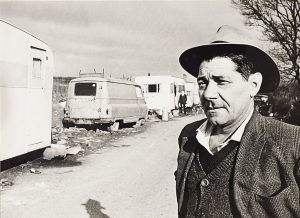
Gypsies camping on Hipton Hill, Norton and Lenchwick, 26th March 1970, Ref: 899;156 WPS 43209
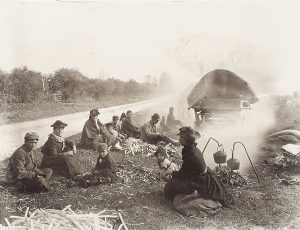
Gypsies at the roadside, one whittling wood, Cookley, Wolverley, 1897, Ref: 899;156 WPS77379
Traditional trades of the Gypsy, Roma and Traveller people were historically land based and on a seasonal basis. Many undertook those which could be taken on the move, such as blacksmithing or hop picking. Hop picking was an attractive source of income as families could time their arrival to coincide with the picking season. Our records show that Gypsy hop pickers were in Leigh in 1913. Our Parish Registers also list several other occupations including ‘Travelling Tinkers’, ‘Tinman’, ‘Basket Maker’, ‘Higgler’, ‘Hawker’ and ‘Chimney sweeper’.
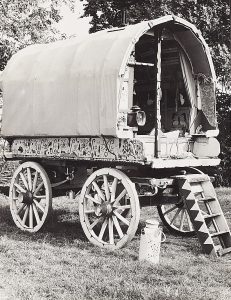
The Romany caravan of Mr A. Butler, Flyford Flavell, 6th October 1966, Ref: 899;156 WPS 36642
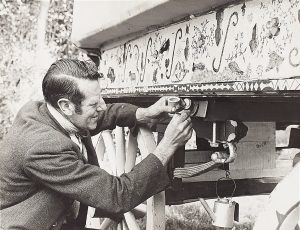
Mr A. Butler decorating his Romany caravan after his previous one had been gutted by a fire, Flyford Flavell, 6th October 1966, Ref: 899;156 WPS 36639
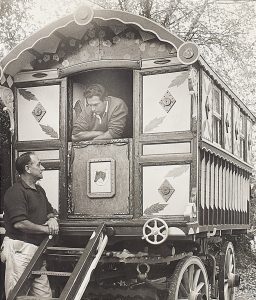
Romany caravan built in 1830, the owner Mr Fletcher talking to his transport manager Mr R. Watkins, Halesowen, 24th October 1969, Ref: 899;156 WPS 43155
Vardos are the traditional horse drawn home of the Romany (Romani) – Gypsies. In the nineteenth century, they came to replace the commonly used bender tent – named so after the construction technique used to bend them into a dome shape. Today, vardos themselves have largely been replaced by the modern trailer and are seldom used. Highly decorated, hand carved and painted with traditional Romany symbols, they were typically built for newly married couples, and can be categorised into six main styles. Worcestershire County Museum at Hartlebury Castle holds the largest collection of vardos in the country.
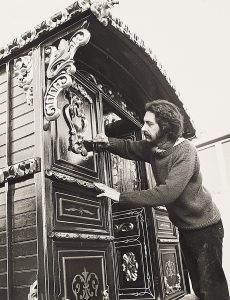
Mr Peter Ingram restoring a Romany Caravan, Hartlebury, 3rd February 1973, Ref: 899;156 WPS 49517
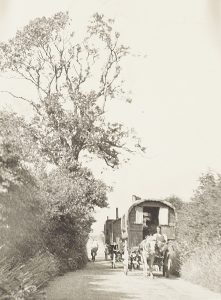
Gypsies travelling in the lane under the Lea of Frankley Beeches, Frankley, 1938, Ref: 899;156 WPS 41391
A travelling lifestyle has been the Gypsy, Roma and Traveller way of life for centuries, but nowadays many live in houses or settled accommodation, due in part to the diminishment of traditional traveller stopping places. Yet there is more to the traveller lifestyle than just the travelling itself. Shared dialects, traditions and rituals – such as elaborate burial ceremonies that include the burning of possessions and trailer or vardo – are as important to the community’s culture. The burning of belongings is done as a sign of respect to the deceased – ensuring they go with them to the afterlife and helping their spirit leave this world for the next. Belongings can also be placed in a person’s coffin for the same reasons. For travelling communities, the grave is considered the final resting place.
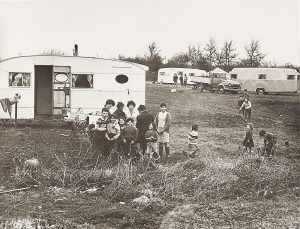
Gypsies near the Alcester Road, Norton, before eviction by Stokes Bomford Ltd, Norton and Lenchwick, 1st February 1968, Ref: 899;156 WPS 39912
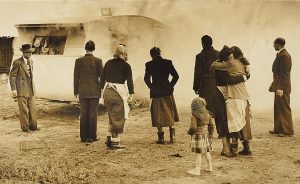
Romany traveller funeral, Old Yardings Farm, Ombersley, 1956, Ref: 899;156 WPS 9114
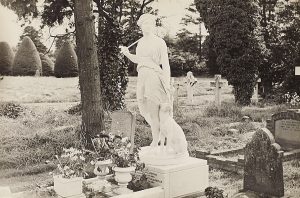
Memorial on Gypsy grave, Bromsgrove, 1951, Ref: 899;156 WPS 857
Though they share similarities, Gypsy, Roma and Traveller are distinct ethnic groups with their own beliefs, languages and customs. For history to accurately represent the wider travelling community, these differences need to be recognised and not overlooked. By learning more about their diverse histories, heritage and cultures, we can help cultivate better understanding of a community that has contributed positively to British society for centuries.
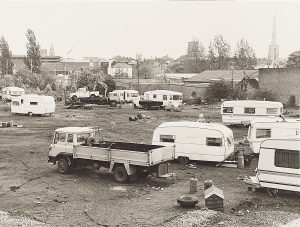
Gypsy caravans parked on land to be used for a trading estate, Hylton Road, Worcester City, 18th May 1983, Ref: 899;156 WPS 57938
The Worcestershire Photographic Society contains 80,020 images, approximately 62,000 of which can be viewed on microfiche in our Self-Service Area. Its text index is also available to search online via our website. Please submit an via our website or speak to someone on the desk if you would like to enquire about viewing them.
We also have a folder containing an index to Gypsy Romany and Traveller families who have passed through Worcestershire, also located in our Self-Service Area.
I was hoping for a more detailed history.
Fascinating. Many facts that I was totally unaware of such as the distinction between the different traveller groups. Wonderful photographs.